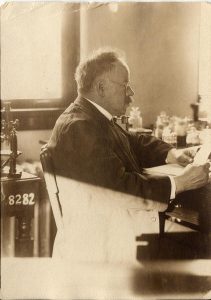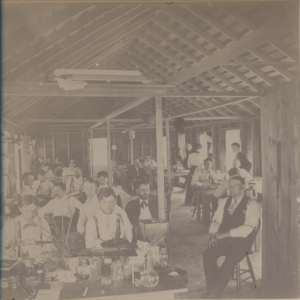
By: Caroline Wickes, Bicentennial Intern, Class of 2017, History and Environmental and Sustainability Studies, Bloomington
This blog is comprised of excerpts from IU’s Biological Field Station podcast.
Imagine a scientist. He or she sits in a lab, surrounded by beakers and test tubes and machinery, processing data and scribbling notes madly into a little notebook. Whether they are studying chemistry, biology, physics, or astronomy, we imagine that the scientist and the lab are inextricably linked.
For Dr. Carl Eigenmann, this was true, but to him the “lab” was very broadly defined. Eigenmann saw the outside world as the best laboratory of all, and he wanted to be sure that his students at Indiana University had access to it.

Dr. Eigenmann is best known for the IU dorm named in his honor, as the first Dean of the Graduate School, and for his groundbreaking work with blindfish. But during his over 40 years as a professor in the department of zoology one of his great legacies at Indiana University was the biological field station.
Eigenmann founded the field station in 1895. He chose the location, on Turkey Lake in northern Indiana, because it had an old boathouse suitable for examining specimen. The goal of the biological station was to make serious statistical inquiry into the evolution of non-migratory vertebrates and to get students out of the classroom and into the field.
In describing the work, Eigenmann says, “Since, wherever he may go, the student must adapt himself to his environment, it is the plan to catch what we can and study what we catch rather than to follow fixed courses.”

During its first year, 19 students spent nine weeks of their summer studying in Kosciusko County. The university allowed them to use the biology department’s zoological apparats. In subsequent years, the numbers compounded.
Enrollment skyrocketed, and by the fourth summer, 103 students attended. Due to the increases in numbers, the station was moved to a new lake on land owned by the Winona Assembly and Summer School.
On Winona Lake two buildings were erected to accommodate students among the water, woods, swamps, and meadows where Cherry Creek enters the lake. Courses offered included zoology, botany, bacteriology, mathematics, embryology, French, and German.
Dr. Eigenmann, in his write up of the station for Science, attributes the upswing to “the conditions for biological work, coupled with camp life on a fine lake, five miles from the nearest village and free from university lecture-hour appointments.”
The environment was pleasurable, but also conducive to the serious research that was undertaken at the field school. Every weekday, students attended one lecture and six hours of work in the field or the laboratory.
On Saturdays, they finished at noon, allowing for some weekend free time. In 1903, the professors were offered $375 to work for the summer, plus 33% of any profit made. Many of IU’s zoology and biology faculty spent at least one summer at the station.

Professors, students, and fellows from other universities also spent the summer at the biological field station and as the first inland biological field station, it set the standard. In 1904, Eigenmann contacted other midwestern universities in regards to their budgets for field work.
The University of Wisconsin wrote back that their budget was so small that they would rather not have it embodied in a statistical table. In this way, Indiana University was a head of its time.
The significance of field stations for universities was rising across the world and Indiana was keeping pace by expanding and refining methods of field research and teaching.
Morton Bradley attended the summer session at the station as a student in 1897 and 1898. Bradley was the beau and future husband of Marie Boisen, granddaughter of Theophilus Wiley, and he wrote her numerous letters while away at the field station. In his letter, Bradley describes the ups and downs of life at the station.
He describes terrible meals, long days of rowing, and lectures. But, there were many happy days spent at the station. Bradley describes days spent playing baseball, a steamer ride around Eagle Lake and an evening spent singing.
On July 13, 1898 he writes, “This morning we—three boys of my class—went out into the woods to hunt flowers. We found some and classified them. Then we concluded that, since it was cool and shady there, we had worked enough for one morning.
Consequently, we went to sleep and slept about an hour and a half, nearly missing our dinners. Botany work is fine!!!”
Like Morton Bradley, many students returned in subsequent years, either as students or research assistants. Scholarships were available for students with specified interest. In a 1920 announcement for the summer session, students are provided a variety of housing options, ranging from free tent camping to $10 a week hotel rooms.

Students at the field station were both male and female. Effa Funk Muhse was a fellow at the station during the summer of 1902, and later went on to become the first woman to receive a Ph.D. from Indiana University.
The field station hosted famous botanist and geneticist Hugo DeVries in 1906. Dr. DeVries introduced the experimental study of organic evolution, which was particularly apt for the field station which focused on evolution of freshwater vertebrates.
Of course things weren’t always perfect. In 1901 Eignemann’s fishing nets which were used to collect specimens were disrupted and confiscated by a Warsaw County deputy for the Department of Fish and Wildlife.
This started a three year long back and forth and a long drawn out trial prep as Warsaw County tried to charge Eigenmann with poaching. Eigenmenn protested, saying that he was doing research for the state university and therefore was acting on the will of the state.
The commissioner of the Department of Fish and Wildlife told Eignemann that many prominent townspeople in Warsaw wanted him prosecuted.

Attorney L. Stookey wrote that the professor should “Stand just before the law as the poorest man we have in this place, and no discrimination must exist.” The deliberations over going to trial continued for three years.
Ultimately Eigenmann was not prosecuted and the biological field station continued, but this incident highlights the complex interactions of the public university and the people of Indiana especially in regards to natural resources and public spaces.
The university serves the people of Indiana, and the people of Indiana make the university better, but they don’t always see eye to eye. The same fecundity of life that made the lake so productive for research purposes also made it an important source of fish for the local people.
The university was able to make peace with Warsaw and the station went on the have many more sunny summers on the beautiful lake.

Eventually the station was forced close in 1938, a victim of low enrollment due to the Great Depression. Indiana University did retain the land though, using it primarily for graduate level research.
In 1961 the Indiana University zoology department decided to sell the land at Winona Lake to the Winona Lake Bible Conference.
In 1965 they purchased land on Crooked Lake, an hour and a half northeast of the original location. The Crooked Lake station started out as a research outpost for studying fish and limnology, but eventually became, much like the original field station, a place for instruction through the IPFW campus.
In 1895 when the station was first used, it started Indiana University’s proud tradition of scientific enquiry in natural spaces. The biological field station was a precursor to the geological field station in Montana and the research and teaching preserve in southern Indiana.

One hundred and twenty-two years later place based research and hands on teaching methods continue to be used by scientists at Indiana University.
Just as Eigenmann saw, the natural world is sometimes the best classroom and laboratory of all.
Read more about the creation of IU’s natural spaces here: https://blogs.iu.edu/bicentennialblogs/2017/04/13/the-creation-of-ius-natural-spaces/
https://blogs.iu.edu/bicentennialblogs/2017/05/25/returning-to-our-roots-the-new-iu-farm/
https://blogs.iu.edu/bicentennialblogs/2017/05/25/explore-the-lilly-dickey-woods/
Primary Sources
Course Catalogue, 1898-1904, Indiana University, Bloomington.
Course Catalogue, 1898-1904, Indiana University, Bloomington.
Correspondence re. funds for fieldwork at other universities and institutions, Carl H. Eigenmann papers 1884-1925, Collection C63, Indiana University, Bloomington.
Moenkhaus, William J. 1903, Carl H. Eigenmann papers 1884-1925, Collection C63, Indiana University, Bloomington.
Morton C. Bradley to Marie Louisa Boisen June 28, 1897, Theophilus Adam Wylie Family Correspondence, Collection 2005.003.2849, Wylie House Museum, Indiana University, Bloomington.
Morton C. Bradley to Marie Louisa Boisen Jul 14, 1898, Theophilus Adam Wylie Family Correspondence, Collection 2005.003.2849, Wylie House Museum, Indiana University, Bloomington.
Morton C. Bradley to Marie Louisa Boisen August 10, 1897, Theophilus Adam Wylie Family Correspondence, Collection 2005.003.2849, Wylie House Museum, Indiana University, Bloomington.
Morton C. Bradley to Marie Louisa Boisen Jul 14, 1898, Theophilus Adam Wylie Family Correspondence, Collection 2005.003.2849, Wylie House Museum, Indiana University, Bloomington.
Notes, fragments of reports, etc., Carl H. Eigenmann papers 1884-1925, Collection C63, Indiana University, Bloomington.
Sweeney, Z. T. 1901-1902, 1907, Carl H. Eigenmann papers 1884-1925, Collection C63, Indiana University, Bloomington.
Payne, Fred 1903, Carl H. Eigenmann papers 1884-1925, Collection C63, Indiana University, Bloomington.
Payne, Fred 1903, Carl H. Eigenmann papers 1884-1925, Collection C63, Indiana University, Bloomington.
Secondary Sources
Biographical Note, Effa Funk Muhse papers, 1895-1915, collection C593, Indiana University, Bloomington.
Kellams, D. (2011 May 31). Summer fun at the biological field station. Indiana University Archives: Blogging Hoosier History. https://blogs.libraries.indiana.edu/iubarchives/2011/05/31/summer-fun-at-the-biological-field-station/
Nei, M & Nozawa, M. (2011 September 6). Roles of mutation and specialization in speciation: From Hugo DeVries to the modern genomic era. Genome Biology and Evolution. Vol. 3. 812-829.
Wylie Staff. (2009 March 11). I.U.’s Turkey Lake biology station. Wiley House Museum. https://wyliehouse.wordpress.com/2009/03/11/iu%E2%80%99s-turkey-lake-biology-station/